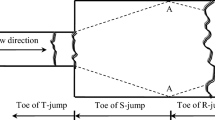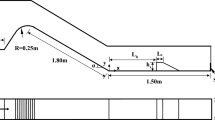Abstract
The formation of a hydraulic jump is the result of rapid transition from supercritical to subcritical flow regime; this phenomenon is always accompanied by energy dissipation. Knowledge of where hydraulic jumps form is necessary to minimize the erosion risk in hydraulic structures. Protecting the floor of stilling basins, channels and rivers is one of the objectives of studying hydraulic jump characteristics. The present work aims to analyze the displacement of the hydraulic jump in a rectangular channel controlled by a sill. It permitted to find a general equation that allows determining the location of the hydraulic jump in a rectangular channel. This formula was obtained through an analysis of the experimental tests carried out at the LARGHYDE laboratory. Comparison between the displacements of the hydraulic jumps measured experimentally and those calculated by the general equation obtained showed that the absolute relative differences between them are mostly less than 10%, which gives validity to the general equation obtained.











Similar content being viewed by others
References
Achour B, Debabeche M (2003) Control of hydraulic jump by sill in a triangular channel. J Hydraul Res 41(3):97–103
Achour B, Khattaoui M (2013) Hysteresis of the hydraulic jump controlled by sill in a rectangular channel. Dam Eng XXIII(4):207–221
Achour B, Sedira N, Debabeche M (2002) Control of hydraulic jump by sill in rectangular channel, Ressaut contrôlé par seuil dans un canal rectangulaire. Larhyss J 1:73–85
Alikhani A, Behrozi-Rad R, Fathi-Moghadam M (2010) Hydraulic jump in stilling basin with vertical end sill. Int Journal of Phys Sci 5(1):25–29
Babaali H, Shamsai A, Vosoughifar H (2015) Computational modeling of the hydraulic jump in the stilling basin with convergence walls using CFD codes. Arab J Sci Eng 40(2):381–395
Baharvand S, Jozaghi A, Fatahi-Alkouhi R, Karimzadeh S, Nasiri R, Lashkar-Ara B (2021) Comparative study on the machine learning and regression-based approaches to predict the hydraulic jump sequent depth ratio. Iran J Sci Technol Trans Civil Eng 45:2719–2732. https://doi.org/10.1007/s40996-020-00526-2
Behrouzi-Rad R, Fathi-Moghadam M, Ghafouri HR, Alikhani A (2013) Generation of hydraulic jump with sill. Wulfenia J 20(2):300–309
Bejestan MS, Neisi K (2009) A new roughened bed hydraulic jump stilling basin. Asian J Appl Sci 2(5):436–445
Debabeche M, Achour B (2007) Effect of sill in the hydraulic jump in a triangular channel. J Hydraul Res 45(1):135–139
Debabeche M, Cherhabil S, Hafnaoui A, Achour B (2009) Hydraulic jump in a sloped triangular channel. Can J Civ Eng 36(4):655–658
Demetriou JD, Dimitriou DJ (2010) A mechanical energy losses comparison in inclined hydraulic jumps over a thin wall and a step. J Hydrodyn 22(5):687–691
Ellayn AF, Sun Z (2012) Hydraulic jump basins with wedge-shaped baffles. J Zhejiang Univ-Sci A (appl Phys Eng) 13(7):519–525
Fathi-Moghadam M, Haghighipour S, Lashkar-Ara B, Aghtouman P (2011) Reduction of stilling basin length with tall end sill. J Hydrodyn 23(4):498–502
Hafnaoui MA, Debabeche M (2021) Numerical modeling of the hydraulic jump location using 2D Iber software. Model Earth Syst Environ 7(3):1939–1946. https://doi.org/10.1007/s40808-020-00942-3
Hafnaoui MA, Debabeche M, Carvalho RF (2018) Modélisation numérique de l’impact des paramètres hydrauliques et numériques sur la localisation du ressaut hydraulique. Courr Savoir 25:61–70
Hafnaoui MA, Carvalho RF, Debabeche M (2016) Prediction of hydraulic jump location in some types of prismatic channels using numerical modelling. In: 6th international junior researcher and engineer workshop on hydraulic structures (IJREWHS 2016) Lübeck, Germany. DOI: https://doi.org/10.15142/T3D01F
Hafnaoui MA (2018) Modélisation numérique du ressaut hydraulique dans quelques types de canaux prismatiques. Doctoral dissertation, Universite Mohamed Khider Biskra, Biskra
Hager WH, Li D (1992) Sill-controlled energy dissipater. J Hydraul Res 30:165–181
Ibrahim MM (2017) Improve the efficiency of stilling basin using different types of blocks. Am J Eng Res (AJER) 6(8):295–304
Kateb S, Debabeche M, Benmalek A (2013) Étude expérimentale de l’effet de la marche positive sur le ressaut hydraulique évoluant dans un canal trapézoïdal. Can J Civil Eng 40:1014–1018
Luo GY, Cao H, Pan H (2021) Method to locate the toe of a hydraulic jump on sloping channels. KSCE J Civ Eng 25:124–139. https://doi.org/10.1007/s12205-020-0081-7
Maatooq JS, Taleb ER (2018) The effects of baffle blocks locations and blockage ratio on the sequent depth and velocity distribution of forced hydraulic jump. In: 7th international symposium on hydraulic structures, Aachen, Germany
Mortensen J, Kubitschek J (2016) Effects of hydraulic jump motion on air entrainment in closed conduits. In: Crookston B, Tullis B (ed), Hydraulic structures and water system management. 6th IAHR international symposium on hydraulic structures, Portland, OR, 27–30 June (pp 528–535). DOI: https://doi.org/10.15142/T380628160853 (ISBN 978-1-884575-75-4)
Nasvi M, Asmeer Z, Mowsoom F, Pathirana K (2010) Correlation among hydraulic parameters of moving hydraulic jump in a rectangular open channel. Engineer XXXXIII(3):20–25
Omid MH, Gord-Noshahri A, Kouchakzadeh S (2010) Sill-controlled hydraulic jump in a gradually expanding channel. Proc Inst Civil Eng Water Manag 163(10):515–522
Parvaresh Rizi A, Kouchakzadeh S, Omid MH (2006) A study of moving hydraulic jumps in rectangular channel. J Appl Sci 6(5):1192–1198
Peterka AJ (1984) Hydraulic design of stilling basins and energy dissipators. United States Department of the Interior, Bureau of Reclamation, Engineering Monograph No. 25, Denver CO, Eighth printing
Pourabdollah N, Heidarpour M, Abedi Koupai J (2019) An experimental and analytical study of a hydraulic jump over a rough bed with an adverse slope and a positive step. Iran J Sci Technol Trans Civil Eng 43:551–561. https://doi.org/10.1007/s40996-018-00230-2
Tokyay ND, Evcimen TU, Şimşek Ç (2011) Forced hydraulic jump on non-protruding rough beds. Can J Civ Eng 38:1136–1144
Zhang J, Zhang Q, Wang T, Li S, Diao Y, Cheng M, Baruch J (2017) Experimental study on the effect of an expanding conjunction between a spilling basin and the downstream channel on the height after jump. Arab J Sci Eng 42(9):4069–4078
Funding
The research was supported by the Directorate General for Scientific Research and Technological Development (DGRSDT), Ministry of Higher Education and Scientific Research.
Author information
Authors and Affiliations
Corresponding author
Ethics declarations
Conflict of interest
The authors declare that no conflict of interest regarding the publication of this paper, and all authors have agreed to publish this paper.
Rights and permissions
Springer Nature or its licensor holds exclusive rights to this article under a publishing agreement with the author(s) or other rightsholder(s); author self-archiving of the accepted manuscript version of this article is solely governed by the terms of such publishing agreement and applicable law.
About this article
Cite this article
Hafnaoui, M.A., Debabeche, M. Displacement of a Hydraulic Jump in a Rectangular Channel: Experimental Study. Iran J Sci Technol Trans Civ Eng 47, 1181–1188 (2023). https://doi.org/10.1007/s40996-022-00974-y
Received:
Accepted:
Published:
Issue Date:
DOI: https://doi.org/10.1007/s40996-022-00974-y




